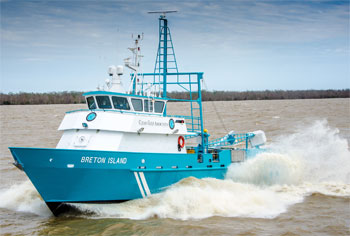Clean Gulf Associates, a New Orleans-based organization formed in 1972, is a nonprofit cooperative of 125 oil and gas companies operating in the Gulf of Mexico.
Clean Gulf recently took delivery of Breton Island, the third in a series of 95-foot oil spill response vessels. They form the first fleet of all-aluminum OSRVs with overnight accommodations in the country. Breton Island, H.I. Rich, and Galveston Island are prepositioned in Venice, La., Leeville, La., and Galveston, Texas, respectively.
The U.S. Coast Guard-certified OSRVs are equipped with an Aptomar-Rutter integrated oil spill detection and communications system.
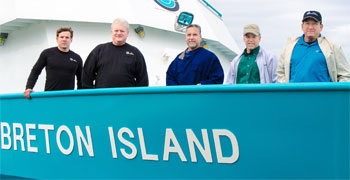 |
|
Benson, Cognevich, Midship Marine owner Randy Hinojosa, Paskewich and Palmisano. |
“It is a military spec infrared camera that is liquid cooled, giving it a high degree of sensitivity,” said Jack Clouse, project manager with CGA Services. The camera can differentiate oil from water by detecting the temperature differences between the two substances. In operation, the X-band radar first detects the oil, then the operator switches over to the infrared camera to stay on the thickest concentration of oil.
“We can stay on the oil through the night, and that’s a big deal,” said Frank Paskewich, Clean Gulf’s executive director. “Our aim was to have the speed to get on the scene quickly and the ability to stay on scene with good seakeeping capability and overnight accommodations.”
The vessels’ top speed is 24 knots and they have accommodations for six.
Paskewich gained confidence in the detection system after H.I. Rich responded to the Black Elk Energy spill southeast of Grand Isle, La., in November 2012. “We rolled that vessel and tracked the oil and the system works. It’s a game-changing tool.”
Deploying the recovery equipment on the aft deck begins with extending the outriggers. Then the Lamor brush skimmers are lifted hydraulically over the rail and lowered into the spill. Booms stretching from the Lamors, port and starboard, across to the outriggers, form a 60-foot catch basin.
The oil adheres to the rotating yellow brushes on the Lamors and is deposited into a 249-barrel storage tank. Most of the water passes back into the sea, as opposed to a weir skimmer system, whereby some water is pumped into the storage system along with the oil.
Frank Palmisano, vice president of CGA Services, said that the brush skimmers are about 80 percent efficient, as opposed to only 20 percent for weir skimmers.
The shallow five-foot draft of Breton Island allows the vessel to hug the coast, while the electronics, accommodations and tankage allow for deepwater work up to 200 miles offshore. “We looked for a gap between working in the shallows in the wetlands and out in deep water,” said Paskewich.
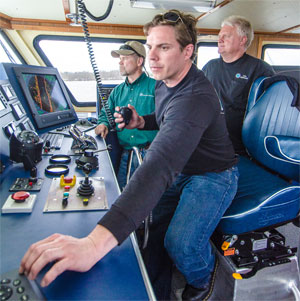 |
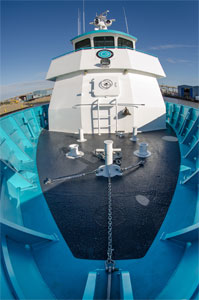 |
|
Mate Chris Benson has the helm, while Clean Gulf Associates Executive Director Frank Paskewich, left, and Capt. Mark Cognevich, right, look on. |
Looking aft from the bow. |
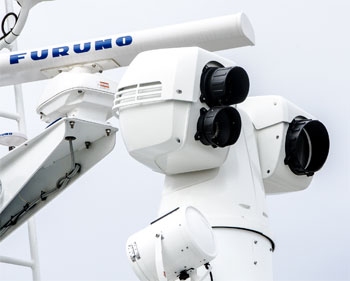 |
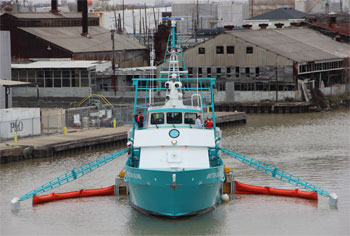 |
|
The nitrogen-cooled infrared cameras, integrated with X-band radar, allow the crew to locate floating oil and to keep the boat in position to collect it in daylight and at night. |
Breton Island with its outriggers and booms deployed. (Photo courtesy Clean Gulf Associates) |
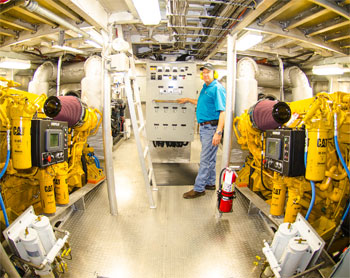 |
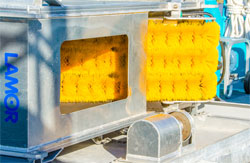 |
|
CGA Services VP Frank Palmisano in the engine room. |
The booms create a 60-foot-wide basin and direct oil to the brush skimmers. |

